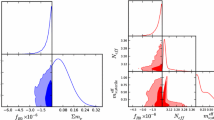Abstract
We refer [1] to the role of an additional O(1) eV sterile neutrino in modified gravity models. We find parameter constraints in particular f(R) gravity model using following up-to-dated cosmological data: measurements of the cosmic microwave background (CMB) anisotropy, the CMB lensing potential, the baryon acoustic oscillations (BAO), the cluster mass function and the Hubble constant. It was obtained for the sterile neutrino mass 0.47 eV < m ν,sterile < 1 eV (2σ) assuming that the sterile neutrinos are thermalized and the active neutrinos are massless, not significantly larger than in the standard cosmology model within the same data set: 0.45 eV < m ν,sterile < 0.92 eV (2σ). But, if the mass of sterile neutrino is fixed and equals ≈ 1.5 eV according to various anomalies in neutrino oscillation experiments, f(R) gravity is much more consistent with observation data than the CDM model.
Similar content being viewed by others
References
A. S. Chudaykin, A. A. Starobinsky, D. S. Gorbunov, and R. A. Burenin, “Cosmology based on gravity with 2(1) eV sterile neutrino,” J. Cosmol. Astropart. P. 05, 004 (2015).
S. Nojiri and S. D. Odintsov, “Introduction to modified gravity and gravitational alternative for dark energy,” Int. J. Geom. Meth. Mod. Phys. 4, 115 (2007).
A. A. Starobinsky, “Disappearing cosmological constant in gravity,” JETP Lett. 86, 157 (2007).
H. Motohashi, A. A. Starobinsky, and J. Yokoyama, “Matter power spectrum in gravity with massive neutrinos,” Prog. Theor. Phys. 124, 541 (2010).
Y. I. Izotov, T. X. Thuan, and N. G. Guseva, “A new determination of the primordial He abundance using the HeI 10830A emission line: Cosmological implications,” Mon. Not. Roy. Astron. Soc. 445,778 (2014).
K. A. Olive et al. (Particle Data Group), “Review of particle physics,” Chin. Phys. C 38, 090001 (2014).
P. Anselmann et al. (GALLEX Collab.), “First results from the Cr-51 neutrino source experiment with the GALLEX detector,” Phys. Lett. B 342, 440 (1995).
D. N. Abdurashitov et al. (SAGE Collab.), “The Russian- American gallium experiment (SAGE) Cr neutrino source measurement,” Phys. Rev. Lett. 77, 4708 (1996).
C. Giunti and M. Laveder, “Statistical significance of the gallium anomaly,” Phys. Rev. C 83, 065504 (2011).
S. A. Appleby, R. A. Battye, and A. A. Starobinsky, “Curing singularities in cosmological evolution of F(R) gravity,” J. Cosmol. Astropart. P. 1006, 005 (2010).
A. De Felice and S. Tsujikawa, “theories,” Living Rev. Rel. 13, 3 (2010).
A. Lewis, A. Challinor, and A. Lasenby, “Efficient computation of cosmic microwave background anisotropies in closed Friedmann-Robertson-Walker models,” Astrophys. J. 538, 473 (2000).
A. Lewis and S. Bridle, “Cosmological parameters from CMB and other data: A Monte-Carlo approach,” Phys. Rev. D 66, 103511 (2002).
P. A. R. Ade et al. (Planck Collab.), “Planck 2013 results. I. Overview of products and scientific results,” Astron. Astrophys. 571, A1 (2014).
C. L. Bennett et al. (SAGE Collab.), “Nine-year Wilkinson microwave anisotropy probe (WMAP) observations: Final maps and results,” AstroPhys. J. Suppl. 208, 20 (2013).
S. Das et al. (ACT Collab.), “The Atacama Cosmology Telescope: temperature and gravitational lensing power spectrum measurements from three seasons of data,” J. Cosmol. Astropart. P. 1404, 014 (2014).
R. Keisler et al. (SPT Collab.), “A measurement of the damping tail of the cosmic microwave background power spectrum with the south pole telescope,” Astrophys. J. 743, 28 (2011).
J. K. Parejko et al. (SDSS-III Collab.), “The clustering of galaxies in the SDSS-III Baryon Oscillation Spectroscopic Survey: The low redshift sample,” Mon. Not. Roy. Astron. Soc. 429, 98 (2013).
C. Maraston et al. (SDSS-III Collab.), “Stellar masses of SDSS-III BOSS galaxies at z ~ 0.5 and constraints to galaxy formation models,” Mon. Not. Roy. Astron. Soc. 435, 2764 (2013).
D. H. Jones, M. A. Read, W. Saunders, M. Colless, T. Jarrett, Q. Parker, A. Fairall, T. Mauch, E. Sadler, F. Watson, D. Burton, L. Campbell, P. Cass, S. Croom, J. Dawe, K. Fiegert, L. Frankcombe, M. Hartley, J. Huchra, D. James, E. Kirby, O. Lahav, J. Lucey, G.Mamon, L. Moore, B. Peterson, S. Prior, D. Proust, K. Russell, V. Safouris, K. Wakamatsu, E. Westra, and M. Williams, “The 6dF Galaxy Survey: Final redshift release (DR3) and southern large-scale structures,” Mon. Not. Roy. Astron. Soc. 399, 683 (2009).
A. G. Riess, L. Macri, S. Casertano, H. Lampeitl, H. C. Ferguson, A. V. Filippenko, S. W. Jha, W. Li, and R. Chornock, “A 3% solution: Determination of the Hubble constant with the Hubble Space Telescope and wide field camera 3,” Astrophys. J. 730, 119 (2011); 732, 129 (2011).
P. A. R. Ade et al. (Planck Collab.), “Planck 2013 results. XVII. Gravitational lensing by large-scale structure,” Astron. Astrophys. 571, A17 (2014).
A. A. Vikhlinin, R. A. Burenin, H. Ebeling, W. R. Forman, A. Hornstrup, C. Jones, A. V. Kravtsov, S. S. Murray, D. Nagai, H. Quintana, and A. Voevodkin, “Chandra cluster cosmology project II: Samples and X-ray data reduction,” Astrophys. J. 692, 1033 (2009).
R. A. Burenin, A. Vikhlinin, A. Hornstrup, H. Ebeling, H. Quintana, and A. Mescheryakov, “The 400 square degree ROSAT PSPC Galaxy Cluster Survey: Catalog and statistical calibration,” Astrophys. J. 172, 561 (2007).
Author information
Authors and Affiliations
Corresponding author
Additional information
Talk at The International Workshop on Prospects of Particle Physics: “Neutrino Physics and Astrophysics” February 1–8, 2015, Valday, Russia.
The article is published in the original.
Rights and permissions
About this article
Cite this article
Chudaykin, A.C. O(1) eV sterile neutrino in f(R) gravity. Phys. Part. Nuclei 48, 55–58 (2017). https://doi.org/10.1134/S1063779616060071
Published:
Issue Date:
DOI: https://doi.org/10.1134/S1063779616060071



